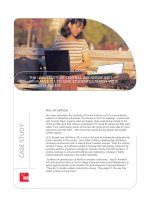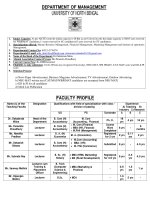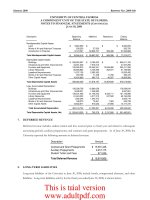REPORT NO. 2009-160 MARCH 2009 UNIVERSITY OF CENTRAL FLORIDA_part3 pdf
Bạn đang xem bản rút gọn của tài liệu. Xem và tải ngay bản đầy đủ của tài liệu tại đây (140.48 KB, 9 trang )
MARCH 2009 REPORT NO. 2009-160
University
RECONCILIATION OF OPERATING LOSS
TO NET CASH USED BY OPERATING ACTIVITIES
Operating Loss (335,837,153)$
Adjustments to Reconcile Operating Loss
to Net Cash Used by Operating Activities:
Depreciation Expense 47,025,821
Change in Assets and Liabilities:
Accounts Receivable (528,746)
Grants and Contracts Receivable (269,687)
Interest Receivable 40,089
Inventories 267,313
Loans and Notes Receivable (193,790)
Other Assets 3,556
Accounts Payable (3,750,981)
Salaries and Wages Payable 1,722,183
Deposits Payable (200,938)
Compensated Absences Payable 1,061,449
Deferred Revenue 2,049,020
Postemployment Health Care Benefits Payable 2,701,000
NET CASH USED BY OPERATING ACTIVITIES (285,910,864)$
SUPPLEMENTAL DISCLOSURE OF NONCASH CAPITAL FINANCING ACTIVITIES
The accompanying notes to financial statements are an integral part of this statement.
Acquired computer equipment and office furniture through installment purchase totaling $2,351,700.
For the Fiscal Year Ended June 30, 2008
UNIVERSITY OF CENTRAL FLORIDA
A COMPONENT UNIT OF THE STATE OF FLORIDA
STATEMENT OF CASH FLOWS (Continued)
-15-
This is trial version
www.adultpdf.com
MARCH 2009 REPORT NO. 2009-160
UNIVERSITY OF CENTRAL FLORIDA
A COMPONENT UNIT OF THE STATE OF FLORIDA
NOTES TO FINANCIAL STATEMENTS
J
UNE 30, 2008
-16-
1. SUMMARY OF SIGNIFICANT ACCOUNTING POLICIES
Reporting Entity
. The University is a separate public instrumentality that is part of the State university
system of public universities, which is under the general direction and control of the Florida Board of
Governors. The University is directly governed by a Board of Trustees (Trustees) consisting of
13 members. The Governor appoints six citizen members and the Board of Governors appoints five
citizen members. These members are confirmed by the Florida Senate and serve staggered terms of five
years. The chair of the faculty senate and the president of the student body of the University are also
members. The Board of Governors establishes the powers and duties of the Trustees. The Trustees are
responsible for setting policies for the University, which provide governance in accordance with State law
and Board of Governors’ Regulations. The Board of Governors, or the Trustees if designated by the
Board of Governors, selects the University President. The University President serves as the executive
officer and the corporate secretary of the Trustees, and is responsible for administering the policies
prescribed by the Trustees.
Criteria for defining the reporting entity are identified and described in the Governmental Accounting
Standards Board’s Codification of Governmental Accounting and Financial Reporting Standards, Sections 2100 and
2600. These criteria were used to evaluate potential component units for which the primary government is
financially accountable and other organizations for which the nature and significance of their relationship
with the primary government are such that exclusion would cause the primary government’s financial
statements to be misleading or incomplete. Based on the application of these criteria, the University is a
component unit of the State of Florida, and its financial balances and activity are reported in the State’s
Comprehensive Annual Financial Report by discrete presentation.
Blended Component Unit
. Based on the application of the criteria for determining component units, the
UCF Finance Corporation (Corporation) is included within the University reporting entity as a blended
component unit. The Corporation was created as the UCF Health Facilities Corporation on
February 1, 2007, to finance, construct, operate, and maintain the health care facilities of the Medical
School for and on behalf of the University. On March 18, 2008, the name was changed to the UCF
Finance Corporation and its purpose was expanded to receive, hold, invest, and administer property and to
make expenditures to or for the benefit of the University of Central Florida.
This is trial version
www.adultpdf.com
MARCH 2009 REPORT NO. 2009-160
UNIVERSITY OF CENTRAL FLORIDA
A COMPONENT UNIT OF THE STATE OF FLORIDA
NOTES TO FINANCIAL STATEMENTS (C
ONTINUED)
J
UNE 30, 2008
-17-
Discretely Presented Component Units
. Based on the application of the criteria for determining
component units, the following direct support organizations (as provided for in Section 1004.28, Florida
Statutes, and Board of Governors Regulation 6C-9.011) are included within the University reporting entity
as discretely presented component units. These legally separate, not-for-profit, corporations are organized
and operated exclusively to assist the University to achieve excellence by providing supplemental resources
from private gifts and bequests, and valuable education support services. The Statute authorizes these
organizations to receive, hold, invest, and administer property and to make expenditures to or for the
benefit of the University. These organizations and their purposes are explained as follows:
¾ The University of Central Florida Foundation, Inc., is a not-for-profit Florida corporation whose
principal function is to provide charitable and educational aid to the University of Central Florida.
¾ The University of Central Florida Research Foundation, Inc., was organized to promote and
encourage, as well as assist in, the research activities of the University’s faculty, staff, and students.
¾ The UCF Athletics Association, Inc., was organized to promote intercollegiate athletics to benefit
the University of Central Florida and surrounding communities.
¾ The UCF Convocation Corporation was created to finance and construct a convocation center, and
to manage the Towers student housing and its related retail space on the north side of campus.
¾ The Golden Knights Corporation was created and operates to finance, build, and administer an on-
campus football stadium.
An annual audit of each organization’s financial statements is conducted by independent certified public
accountants. The annual report is submitted to the Auditor General and the University Board of Trustees.
Additional information on the University’s discretely presented component units, including copies of audit
reports, is available by contacting the University Controller. Condensed financial statements for the
University’s discretely presented component units are shown in a subsequent note.
Basis of Presentation
. The University’s accounting policies conform with accounting principles generally
accepted in the United States of America applicable to public colleges and universities as prescribed by the
Governmental Accounting Standards Board (GASB). The National Association of College and University
Business Officers (NACUBO) also provides the University with recommendations prescribed in
accordance with generally accepted accounting principles promulgated by GASB and the Financial
Accounting Standards Board (FASB). GASB allows public universities various reporting options. The
University has elected to report as an entity engaged in only business-type activities. This election requires
the adoption of the accrual basis of accounting and entitywide reporting including the following
components:
This is trial version
www.adultpdf.com
MARCH 2009 REPORT NO. 2009-160
UNIVERSITY OF CENTRAL FLORIDA
A COMPONENT UNIT OF THE STATE OF FLORIDA
NOTES TO FINANCIAL STATEMENTS (C
ONTINUED)
J
UNE 30, 2008
-18-
¾ Management’s Discussion and Analysis
¾ Basic Financial Statements:
• Statement of Net Assets
• Statement of Revenues, Expenses, and Changes in Net Assets
• Statement of Cash Flows
• Notes to Financial Statements
Basis of Accounting
. Basis of accounting refers to when revenues, expenses, and related assets and
liabilities are recognized in the accounts and reported in the financial statements. Specifically, it relates to
the timing of the measurements made, regardless of the measurement focus applied. The University’s
financial statements are presented using the economic resources measurement focus and the accrual basis
of accounting. Revenues, expenses, gains, losses, assets, and liabilities resulting from exchange and
exchange-like transactions are recognized when the exchange takes place. Revenues, expenses, gains,
losses, assets, and liabilities resulting from nonexchange activities are generally recognized when all
applicable eligibility requirements, including time requirements, are met.
‘The University’s discretely presented component units use the accrual basis of accounting whereby
revenues are earned and expenses are recognized when incurred, and follow GASB standards of
accounting and financial reporting.
The University follows FASB statements and interpretations issued after November 30, 1989, unless those
pronouncements conflict with GASB pronouncements.
Interdepartmental sales between auxiliary service departments and other institutional departments have
been accounted for as reductions of expenses and not revenues of those departments.
The University’s principal operating activities consist of instruction, research, and public service.
Operating revenues and expenses generally include all fiscal transactions directly related to these activities
as well as administration, operation and maintenance of capital assets, and depreciation on capital assets.
Nonoperating revenues include State appropriations, Federal and State student financial aid, investment
income (net of unrealized gains or losses on investments), and revenues for capital construction projects.
Interest on capital asset-related debt is a nonoperating expense.
The statement of net assets is presented in a classified format to distinguish between current and
noncurrent assets and liabilities. When both restricted and unrestricted resources are available to fund
This is trial version
www.adultpdf.com
MARCH 2009 REPORT NO. 2009-160
UNIVERSITY OF CENTRAL FLORIDA
A COMPONENT UNIT OF THE STATE OF FLORIDA
NOTES TO FINANCIAL STATEMENTS (C
ONTINUED)
J
UNE 30, 2008
-19-
certain programs, it is the University’s policy to first apply the restricted resources to such programs,
followed by the use of the unrestricted resources.
The statement of revenues, expenses, and changes in net assets is presented by major sources and is
reported net of tuition scholarship allowances. Tuition scholarship allowances are the differences between
the stated charge for goods and services provided by the University and the amount that is actually paid by
a student or a third party making payment on behalf of the student. The University applied “The Alternate
Method” as prescribed in NACUBO Advisory Report 2000-05 to determine the reported net tuition
scholarship allowances. Under this method, the University computes these amounts by allocating the cash
payments to students, excluding payments for services, on a ratio of total aid to the aid not considered to
be third-party aid.
The statement of cash flows is presented using the direct method in compliance with GASB Statement
No. 9, Reporting Cash Flows for Proprietary and Nonexpendable Trust Funds and Governmental Entities That Use
Proprietary Fund Accounting.
Capital Assets
. University capital assets consist of land, buildings, construction in progress, infrastructure
and other improvements, furniture and equipment, leasehold improvements, library resources, works of art
and historical treasures, and other capital assets. These assets are capitalized and recorded at cost at the
date of acquisition or at estimated fair value at the date received in the case of gifts and purchases of State
surplus property. Additions, improvements, and other outlays that significantly extend the useful life of an
asset are capitalized. Other costs incurred for repairs and maintenance are expensed as incurred. The
University has a capitalization threshold of $1,000 for tangible personal property and $100,000 for new
buildings and improvements. Depreciation is computed on the straight-line basis over the following
estimated useful lives:
¾ Buildings – 20 to 50 years
¾ Infrastructure and Other Improvements – 12 to 50 years
¾ Furniture and Equipment – 5 to 10 years
¾ Library Resources – 10 years
¾ Leasehold Improvements – 10 years
¾ Works of Art and Historical Treasures – 5 to 15 years
Noncurrent Liabilities
. Noncurrent liabilities include principal amounts of bonds payable, loans and
notes payable, installment purchases payable, compensated absences, and postemployment health care
benefits payable that are not scheduled to be paid within the next fiscal year and other noncurrent
This is trial version
www.adultpdf.com
MARCH 2009 REPORT NO. 2009-160
UNIVERSITY OF CENTRAL FLORIDA
A COMPONENT UNIT OF THE STATE OF FLORIDA
NOTES TO FINANCIAL STATEMENTS (C
ONTINUED)
J
UNE 30, 2008
-20-
liabilities. Bonds payable are reported net of unamortized premium or discount and deferred losses on
refunding. The University amortizes bond premiums and discounts over the life of the bonds using the
straight-line method. Deferred losses on refundings are amortized over the life of the old debt or new debt
(whichever is shorter) using the straight-line method. Issuance cost paid from the debt proceeds are
reported as deferred charges, and are amortized over the life of the bonds using the straight-line method.
2. CASH AND CASH EQUIVALENTS
Cash and cash equivalents consist of cash on hand, cash in demand accounts, and money market funds.
Except as noted below, University cash deposits are held in banks qualified as public depositories under
Florida law. All such deposits are insured by Federal depository insurance, up to specified limits, or
collateralized with securities held in Florida’s multiple financial institution collateral pool required by
Chapter 280, Florida Statutes. The UCF Finance Corporation, a blended component unit, holds
$53 million in money market funds which are not considered public deposits and are not subject to the
qualified public depository requirement. Cash and cash equivalents that are externally restricted to make
debt service payments, maintain sinking or reserve funds, or purchase or construct capital or other
restricted assets are classified as restricted.
Component Units
. Amounts reported as restricted cash and cash equivalents include guaranteed
investment contracts and money market funds. The guaranteed investment contracts were purchased by
the component units to invest bond proceeds for the various construction projects on campus.
3. INVESTMENTS
Section 1011.42(5), Florida Statutes, authorizes universities to invest funds with the State Treasury and
State Board of Administration, and requires that universities comply with the statutory requirements
governing investment of public funds by local governments. Accordingly, universities are subject to the
requirements of Chapter 218, Part IV, Florida Statutes. Pursuant to Section 218.415(16), Florida Statutes,
the University is authorized to invest in the Local Government Surplus Funds Trust Fund investment pool
administered by the State Board of Administration; interest-bearing time deposits and savings accounts in
qualified public depositories, as defined in Section 280.02, Florida Statutes; direct obligations of the United
States Treasury; obligations of Federal agencies and instrumentalities; securities of, or interests in, certain
open-end or closed-end management type investment companies; Securities and Exchange Commission
registered money market funds with the highest credit quality rating from a nationally recognized rating
agency; and other investments approved by the University’s Board of Trustees as authorized by law.
This is trial version
www.adultpdf.com
MARCH 2009 REPORT NO. 2009-160
UNIVERSITY OF CENTRAL FLORIDA
A COMPONENT UNIT OF THE STATE OF FLORIDA
NOTES TO FINANCIAL STATEMENTS (C
ONTINUED)
J
UNE 30, 2008
-21-
Investments set aside to make debt service payments, maintain sinking or reserve funds, or to purchase or
construct capital assets are classified as restricted.
The University’s investments at June 30, 2008, are reported at fair value, as follows:
Investment Type Amount
External Investment Pools:
State Treasury Special Purpose Investment Account 253,666,488$
State Board of Administration Local Government
Surplus Funds Trust Fund 958
State Board of Administration Fund B Surplus Funds
Trust Fund 489
Total University Investments
253,667,935$
External Investment Pools
The University reported investments at fair value totaling $253,666,488 at June 30, 2008, in the State
Treasury Special Purpose Investment Account (SPIA) investment pool, representing ownership of a share
of the pool, not the underlying securities. The SPIA carried a credit rating of AA-f by Standard and Poor’s
and had an effective duration of 3.31 years at June 30, 2008. The University relies on policies developed by
the State Treasury for managing interest rate risk or credit risk for this investment pool.
Component Units Investments
Investments held by the University’s component units at June 30, 2008, are reported at fair value as
follows:
Investment Type University of University of Total
Central Florida Central Florida
Foundation, Research
Inc. Foundation,
Inc.
Mutual Funds - Bonds 54,973,330$ $ 54,973,330$
Mutual Funds - Equities 45,596,955 52,500 45,649,455
Equity Pooled Investment Fund 30,940,380 30,940,380
Stocks and Other Equity Securities 83,436 379,812 463,248
Total Component Units Investments
131,594,101$ 432,312$ 132,026,413$
The vast majority of component units’ investments are those of the University of Central Florida
Foundation, Inc. (Foundation). The Foundation’s uncategorized investments, excluding mutual funds, are
uninsured and registered in SunTrust Bank’s nominee name as custodian for the Foundation, with
This is trial version
www.adultpdf.com
MARCH 2009 REPORT NO. 2009-160
UNIVERSITY OF CENTRAL FLORIDA
A COMPONENT UNIT OF THE STATE OF FLORIDA
NOTES TO FINANCIAL STATEMENTS (C
ONTINUED)
J
UNE 30, 2008
-22-
securities held by the Foundation’s agent in the Foundation’s name. Mutual funds do not have specific
securities and are held in book-entry form.
Interest Rate Risk: Interest rate risk is the risk that changes in interest rates of debt investments will
adversely affect the fair value of an investment.
The following schedule of bond mutual funds represents average duration for debt instruments:
Average Duration Fair Value
Greater Than Five Years 1,093,255$
One to Five Years 47,088,982
Less Than One Yea
r
6,791,093
Total
54,973,330
$
Credit risk: Credit risk is the risk that an issuer or other counterparty to an investment will not fulfill its
obligations. The following schedule represents the rating of the Foundation’s investments in bond mutual
funds using Standard and Poor’s, nationally recognized statistical rating organization:
Qualit
y
Ratin
g
Fair Value
S&P AA1 40,206,668$
S&P AAA 6,791,093
S&P AA+ 1,093,255
S&P AA 4,939,881
S&P B
A
1,942,433
T
ota
l
5
4
,
9
7
3
,
330
$
Custodial Credit Risk: Custodial credit risk is the risk that in the event of the failure of the counterparty to a
transaction, the Foundation will not be able to recover the value of its investments or collateral securities
that are in the possession of an outside party. As of June 30, 2008, the Foundation had no securities of
this nature.
Concentration of Credit Risk: Concentration of credit risk is the risk of loss attributed to the magnitude of an
entity’s investment in a single issuer. The Foundation’s investment policy requires diversification of
investments sufficient to reduce the potential of a single security, single sector of securities, or single style
of management having a disproportionate or significant impact on the portfolio. Guidelines for individual
sectors of the portfolio further indicate percentage limitations.
This is trial version
www.adultpdf.com
MARCH 2009 REPORT NO. 2009-160
UNIVERSITY OF CENTRAL FLORIDA
A COMPONENT UNIT OF THE STATE OF FLORIDA
NOTES TO FINANCIAL STATEMENTS (C
ONTINUED)
J
UNE 30, 2008
-23-
4. RECEIVABLES
Accounts Receivable
. Accounts receivable represent amounts for student tuition and fees, contract and
grant reimbursements due from third parties, various sales and services provided to students and third
parties, and interest accrued on investments and loans receivable. As of June 30, 2008, the University
reported the following amounts as net accounts receivable.
Description Amount
Contracts and Grants 18,438,260$
Student Tuition and Fees 10,006,909
Other 3,419,559
Total
31,864,728$
Loans and Notes Receivable
. Loans and notes receivable represent amounts owed on promissory notes
from debtors, including student loans made under the Federal Perkins Loan Program and other loan
programs.
Allowance for Uncollectible Receivables
. Allowances for uncollectible accounts, and loans and notes
receivable, are reported based upon management’s best estimate as of fiscal year-end considering type, age,
collection history, and other factors considered appropriate. Accounts receivable, and loans and notes
receivable, are reported net of allowances of $1,085,740 and $257,556, respectively, at June 30, 2008.
5. DUE FROM STATE
Due from State is the amount of Public Education Capital Outlay, General Revenue, Capital Improvement
Fee Trust Fund, or other allocations due from the State for construction of University facilities.
6. CAPITAL ASSETS
Capital assets activity for the fiscal year ended June 30, 2008, is shown below:
This is trial version
www.adultpdf.com









